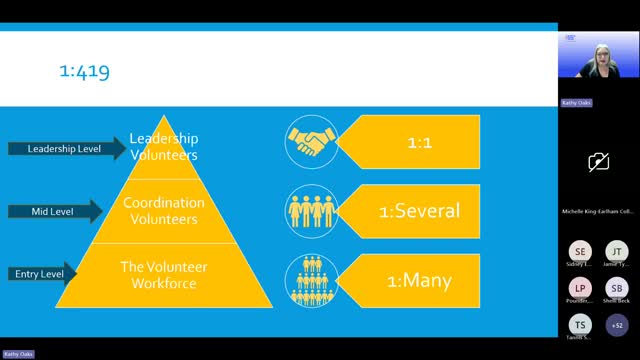American Cancer Society enhances volunteer leadership model for better engagement
September 20, 2024 | Commission on Aging and Disability, Deparments in Office of the Governor, Organizations, Executive, Tennessee
This article was created by AI summarizing key points discussed. AI makes mistakes, so for full details and context, please refer to the video of the full meeting. Please report any errors so we can fix them. Report an error »

The Tennessee Commission on Aging and Disability convened on September 20, 2024, to discuss the Volunteer Staff Partnership, focusing on the effective integration of volunteers within organizational structures. The meeting highlighted the importance of establishing a leadership hierarchy among volunteers, emphasizing the roles of entry-level, mid-level, and leadership volunteers in managing and engaging with the broader volunteer workforce.
The discussion began with an overview of the volunteer management structure, where one staff member oversees a significant number of volunteers—specifically, a ratio of one staff member for every 419 volunteers at the American Cancer Society. This structure necessitates a reliance on volunteers to manage relationships and tasks, allowing staff to focus on strategic oversight rather than direct management.
Key points included the necessity of promoting volunteers through various levels of responsibility. The meeting underscored the potential for mid-level volunteers to take on coordination roles, thereby enhancing the organization's capacity to engage volunteers effectively. This approach not only empowers volunteers but also fosters a culture of partnership where staff and volunteers work collaboratively towards shared goals.
The conversation also addressed the critical role of trust and clear expectations in volunteer management. Staff members are encouraged to transition from a traditional management role to one that emphasizes engagement and partnership. This shift is seen as essential for creating a successful volunteer staff partnership culture, where volunteers are not merely managed but actively engaged in the mission of the organization.
Examples from the American Cancer Society illustrated how volunteers contribute to strategic planning and community engagement. Volunteers are involved in determining organizational goals and objectives, leading programs, and delivering services to clients. This collaborative approach ensures that volunteers have a voice in the organization, enhancing their commitment and effectiveness.
The meeting concluded with a call to action for organizations to embrace this model of volunteer engagement. By recognizing the unique contributions of volunteers and fostering a culture of partnership, organizations can enhance their impact and better serve their communities. The emphasis was placed on the importance of aligning volunteer efforts with the organization's mission, ensuring that all volunteer activities contribute meaningfully to the overarching goals.
The discussion began with an overview of the volunteer management structure, where one staff member oversees a significant number of volunteers—specifically, a ratio of one staff member for every 419 volunteers at the American Cancer Society. This structure necessitates a reliance on volunteers to manage relationships and tasks, allowing staff to focus on strategic oversight rather than direct management.
Key points included the necessity of promoting volunteers through various levels of responsibility. The meeting underscored the potential for mid-level volunteers to take on coordination roles, thereby enhancing the organization's capacity to engage volunteers effectively. This approach not only empowers volunteers but also fosters a culture of partnership where staff and volunteers work collaboratively towards shared goals.
The conversation also addressed the critical role of trust and clear expectations in volunteer management. Staff members are encouraged to transition from a traditional management role to one that emphasizes engagement and partnership. This shift is seen as essential for creating a successful volunteer staff partnership culture, where volunteers are not merely managed but actively engaged in the mission of the organization.
Examples from the American Cancer Society illustrated how volunteers contribute to strategic planning and community engagement. Volunteers are involved in determining organizational goals and objectives, leading programs, and delivering services to clients. This collaborative approach ensures that volunteers have a voice in the organization, enhancing their commitment and effectiveness.
The meeting concluded with a call to action for organizations to embrace this model of volunteer engagement. By recognizing the unique contributions of volunteers and fostering a culture of partnership, organizations can enhance their impact and better serve their communities. The emphasis was placed on the importance of aligning volunteer efforts with the organization's mission, ensuring that all volunteer activities contribute meaningfully to the overarching goals.
View full meeting
This article is based on a recent meeting—watch the full video and explore the complete transcript for deeper insights into the discussion.
View full meeting
